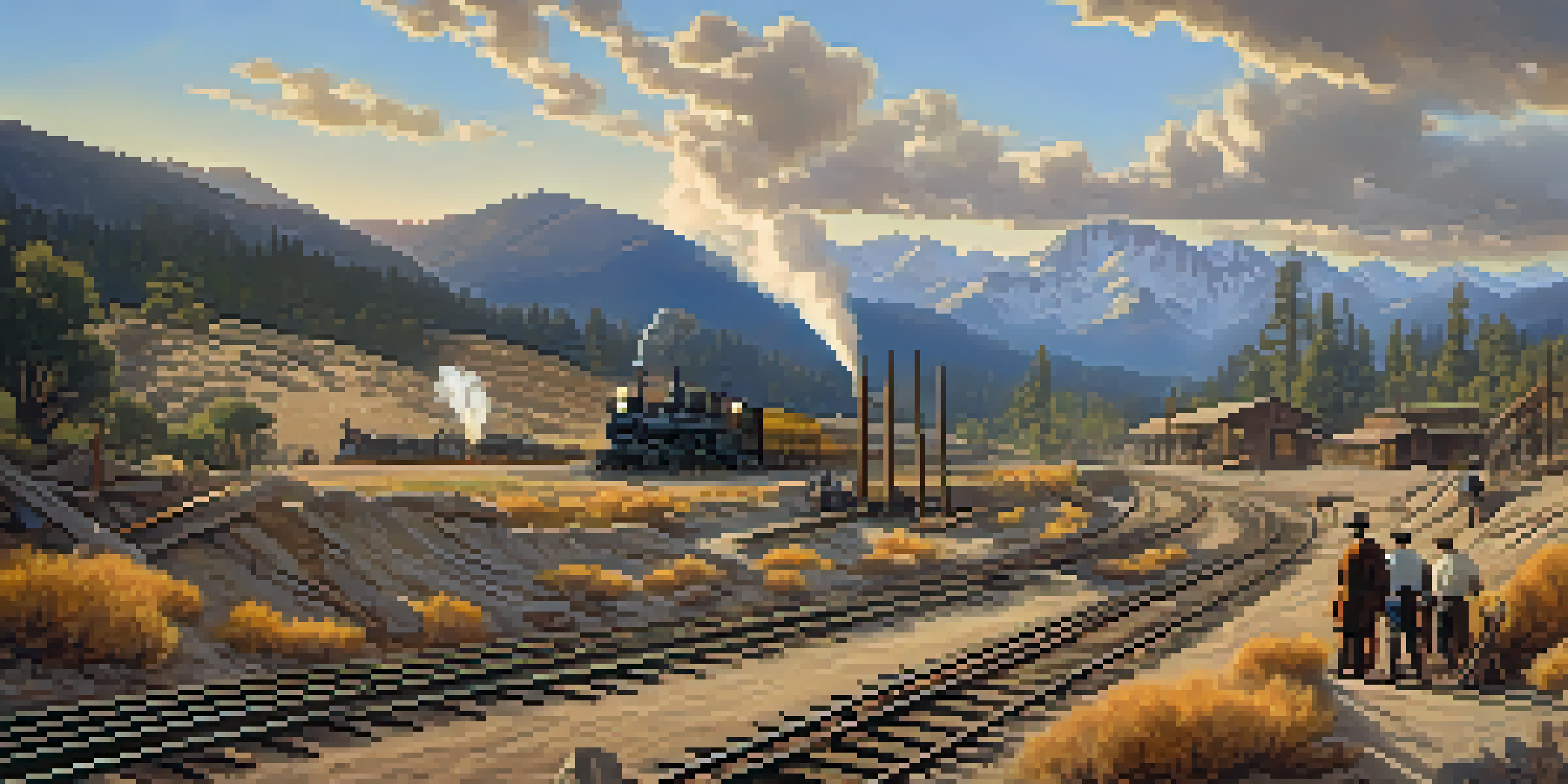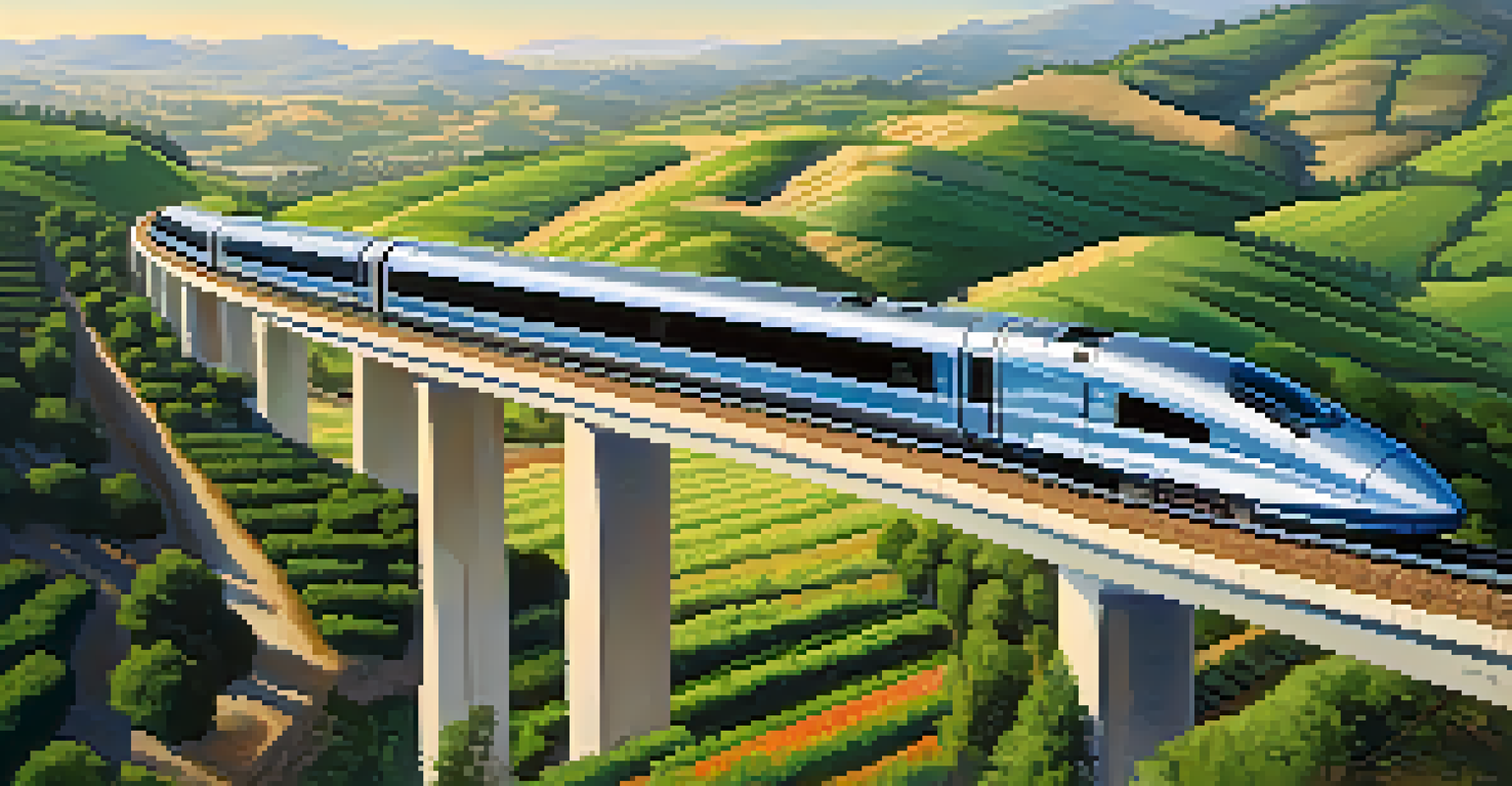The Birth of California's Railroads: A Historical Overview

The Early Beginnings of Railroads in California
The story of railroads in California begins in the mid-19th century, a period marked by rapid growth and development. With the Gold Rush of 1849, thousands flocked to the state, creating a pressing need for efficient transportation. The idea of a railroad emerged as a solution to connect burgeoning towns and facilitate the movement of goods and people across the vast landscape.
The railroad is a more economical mode of transportation than the wagon or the horse, and it will always be used as long as it is properly managed.
Initially, the concept was met with skepticism, as many believed the rugged terrain would make railroad construction nearly impossible. However, pioneers like Leland Stanford and his associates were determined to push forward, believing that railroads would not only serve the gold miners but also the agricultural and industrial sectors. Their vision began to take shape with the establishment of the Central Pacific Railroad in 1861.
By the late 1860s, the dream of a transcontinental railroad became a reality, culminating in the famous Golden Spike ceremony in 1869. This monumental achievement connected California to the rest of the United States, marking the beginning of a new era in transportation and commerce.
Challenges Faced During Railroad Construction
Building railroads in California was no small feat, as the state is characterized by its diverse and often challenging geography. Workers faced numerous obstacles, including mountain ranges like the Sierra Nevada, arid deserts, and lush valleys. These geographical challenges required innovative engineering solutions, such as tunnels and bridges, to navigate the landscape effectively.

Labor shortages posed another significant challenge, particularly during the peak years of construction. To meet the demand for workers, railroad companies recruited thousands of immigrants, many of whom were Chinese laborers. These workers faced harsh conditions and dangerous tasks, yet their contributions were pivotal in completing the railroads on time.
Railroads Transformed California's Economy
The arrival of railroads facilitated trade and job creation, leading California to evolve into a diverse economic powerhouse.
Moreover, financial hurdles often threatened the projects' progress. The construction of railroads required substantial investment, and many companies struggled to secure the necessary funds. Despite these challenges, the perseverance of railroad tycoons and laborers ultimately led to the successful completion of key rail lines.
The Impact of Railroads on California's Economy
The arrival of railroads had a transformative effect on California's economy, acting as a catalyst for growth and development. With improved transportation, goods could be moved more efficiently, connecting farmers in the Central Valley with markets in San Francisco and beyond. This accessibility stimulated trade, allowing agriculture and industry to flourish.
The railroads are the arteries of commerce, and the pulse of prosperity beats in their tracks.
Moreover, the railroads created new job opportunities, not only in construction but also in various sectors such as manufacturing and logistics. Towns sprouted along the rail lines, leading to the establishment of vibrant communities. This urbanization played a crucial role in shaping California's demographic landscape and overall economic prosperity.
As a result, California transitioned from a largely agrarian society to a more diverse economy that included mining, agriculture, and emerging industries. The railroads were the backbone of this economic transformation, paving the way for the state's future as a powerhouse in the nation.
Cultural Changes Brought by the Railroads
Railroads not only transformed California's economy but also significantly impacted its culture and society. As people moved westward, they brought with them diverse customs, traditions, and ideas. This melting pot of cultures enriched California's social fabric, leading to a unique blend of influences that can still be seen today.
The railroads also made travel more accessible to the general public. Families could visit relatives across the state, and tourists began exploring California's natural wonders, like the majestic Yosemite National Park. This newfound accessibility fostered a sense of unity and pride among Californians, as they could easily connect with one another and their land.
Cultural Exchange Through Railroads
Railroads enabled the movement of people and ideas, enriching California's cultural fabric and fostering a sense of unity.
Additionally, the railroads played a crucial role in spreading information. Newspapers and literature could be transported quickly, allowing ideas and news to circulate more freely. This exchange of information contributed to a more informed and engaged citizenry, shaping California's social and political landscape.
Technological Innovations in Railroad Construction
The construction of California's railroads was marked by several technological innovations that revolutionized the industry. The use of steam locomotives allowed for faster and more efficient transportation of goods and passengers. This technology, combined with advancements in materials like steel, made it possible to build more robust tracks that could withstand the state's diverse climates.
Another significant innovation was the development of signaling and communication systems. These systems improved safety and coordination on the railroads, enabling trains to operate more smoothly. As a result, accidents became less frequent, and confidence in rail travel grew among the public.
Moreover, the introduction of specialized railcars, such as refrigerated cars, changed the way perishable goods were transported. This innovation extended the market reach for California's agricultural products, allowing fresh produce to be shipped across the country. These technological advancements not only improved efficiency but also enhanced the overall reliability of railroad services.
The Role of Railroads in the 20th Century
As the 20th century rolled in, California's railroads continued to play a vital role in the state's landscape. They served as critical infrastructure for both the military during World Wars I and II and for the booming post-war economy. Railroads facilitated the movement of troops and supplies, demonstrating their importance beyond just commercial use.
During this period, however, the rise of the automobile and interstate highways began to change the transportation dynamics. Many passengers opted for cars over trains, leading to a decline in rail travel. In response, railroad companies adapted by focusing on freight services, which remained a crucial part of the supply chain.
Innovations Shaped Railroad Construction
Technological advancements in materials and systems revolutionized railroad construction, improving efficiency and safety.
Despite facing challenges, California's railroads remained integral to the state's growth. They supported the development of industries like oil and agriculture, ensuring that products could be transported efficiently across vast distances. This adaptability underscored the resilience of California’s railroads as they navigated an ever-evolving economic landscape.
The Future of Railroads in California
Today, California's railroads are at a crossroads, facing new challenges and opportunities in the 21st century. With growing concerns about climate change and traffic congestion, there is a renewed interest in revitalizing rail travel as a sustainable transportation option. High-speed rail projects, such as California's ambitious high-speed rail initiative, aim to connect major cities and reduce carbon emissions.
Additionally, advancements in technology are reshaping the railroad industry. Innovations like automated train systems and improved scheduling software promise to enhance efficiency and safety. These developments not only modernize the infrastructure but also attract a new generation of travelers who value convenience and sustainability.

As California continues to grow, the future of its railroads will likely involve a blend of tradition and innovation. Balancing the rich history of railroads with the need for modern solutions will be essential in shaping the next chapter of this vital transportation network.